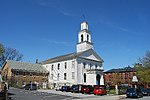Grey's raid

Grey's raid was a series of raids carried out in Massachusetts by British forces under the command of Major-General Charles Grey in September 1778 during the American Revolutionary War. Grey, leading 4,000 troops, raided the towns of New Bedford and Fairhaven along with Martha's Vineyard as part of the northern theater of the American Revolutionary War after Saratoga. The raids were the one of the first in a series of attacks executed by the British against American coastal communities. Grey's force was originally intended as a relief force for the British garrison at Newport, Rhode Island that was briefly under siege, but they arrived after the American besiegers had already retreated. General Sir Henry Clinton diverted Grey's troops to carry out raids instead. On September 5 and 6, Grey raided New Bedford and Fairhaven, encountering significant resistance only in Fairhaven. His troops destroyed storehouses, shipping, and supplies in New Bedford, where they met with light resistance from the local militia; they damaged fewer American holds at Fairhaven where militia resistance had additional time to organize. He then sailed for Martha's Vineyard, which was undefended. Between September 10 and 15, its residents surrendered 10,000 head of sheep and 300 oxen, as well as most of the island's weapons.
Excerpt from the Wikipedia article Grey's raid (License: CC BY-SA 3.0, Authors, Images).Grey's raid
Cedar Street, New Bedford
Geographical coordinates (GPS) Address Nearby Places Show on map
Geographical coordinates (GPS)
| Latitude | Longitude |
|---|---|
| N 41.636111111111 ° | E -70.934722222222 ° |
Address
Cedar Street 58;60;62;64;66;68
02740 New Bedford
Massachusetts, United States
Open on Google Maps






